Ethiopia has over 20 national parks, but none so famous as the Simien Mountains National Park, guardian of Ethiopia’s highest peak, Ras Dejen at 14,905 ft. The Simien Mountains are known throughout the world for their wildly dramatic scenery as jagged mountain peaks flank deep valleys often referred to as “Africa’s Grand Canyon.”
The Simien Mountains National Park was created initially as a protection area for a number of endangered species, including the Ethiopian wolf and the walia ibex, a wild goat found nowhere else in the world. The ibex is believed to be one of the most endangered mammal species on the planet. For this reason, the national park was one of the first sites to be protected by UNESCO World Heritage back in 1978.
Heading into the park, we would be back in the tents again for three nights of camping. We stopped in Debark, considered the “frontier town” before entering the park to pick up our two guides and our two “scouts.” Each of the three days, there would be two hikes on offer, a short one of two to four hours, and a long one of four to six hours. The two guides would lead these two hikes, and the two rifle-carrying scouts would be the sweeps. Both are a requirement for hiking within the park boundaries. We are told that the reason for hiring the scouts is more to help local employment, as there are no real safety issues.
Debark also has camping gear for rent. Based on experience, Louise recommended we consider renting an “outer” sleeping bag to go over our own bedding. While my REI sleep bag is rated for three seasons, temperatures were predicted to drop below freezing at our higher camp. Waking up with frost on the tent, I was certainly glad I had heeded Louise’s advice!

Stopped in Debark before heading into the park, Louise bargains for a bundle of firewood.

It doesn’t matter what you are doing in Ethiopia, you will always ALWAYS have an audience! This crowd has assembled just to watch Louise load the firewood into the truck.

It’s market day in Debark, as the local herders come into town to sell their livestock. A small goat will cost you about 3,000 Birr, just under a hundred bucks.

Entering the gates of the Simien Mountains National Park, celebrating 50 years of conservancy.

Just inside the national park is the Simien Park Lodge, which at 10,700 ft boasts being “the highest lodge in Africa.”

Most of the hiking on the shorter hikes is done along the ridge, offering sweeping views.

Our driver, James, is a rock climber, so he is getting ideas for some new routes here.

Most of the formations in the park are due to volcanic erosion.
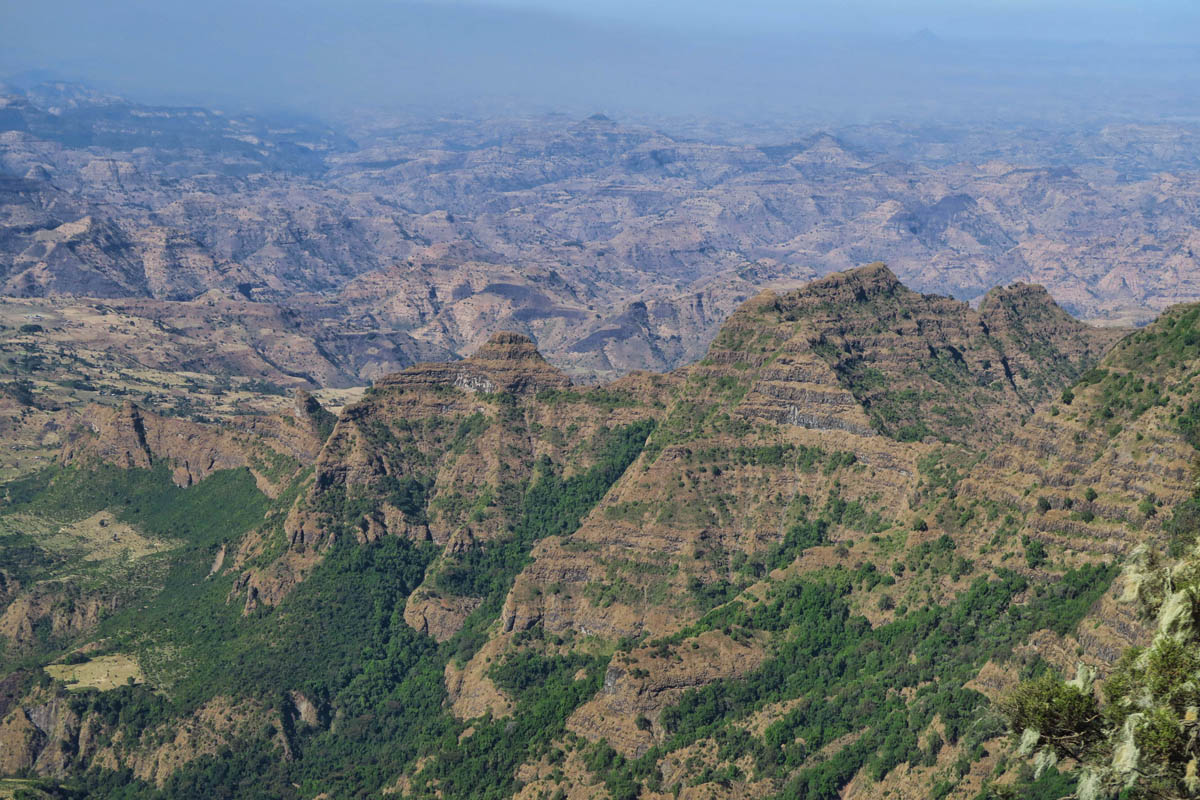
The park is often referred to as “Africa’s Grand Canyon.” Here, it is easy to see why…

While the hiking along the ridge appears fairly level, there is actually a lot of elevation change along the undulating ridge.

Local people selling woven trinkets are frequent along the lower elevation trails.

I was sad not to be able to hang in there for the fast paced longer hikes, but the shorter hikes were also beautiful. As is always the case, I could have done the distance, just not the speed.
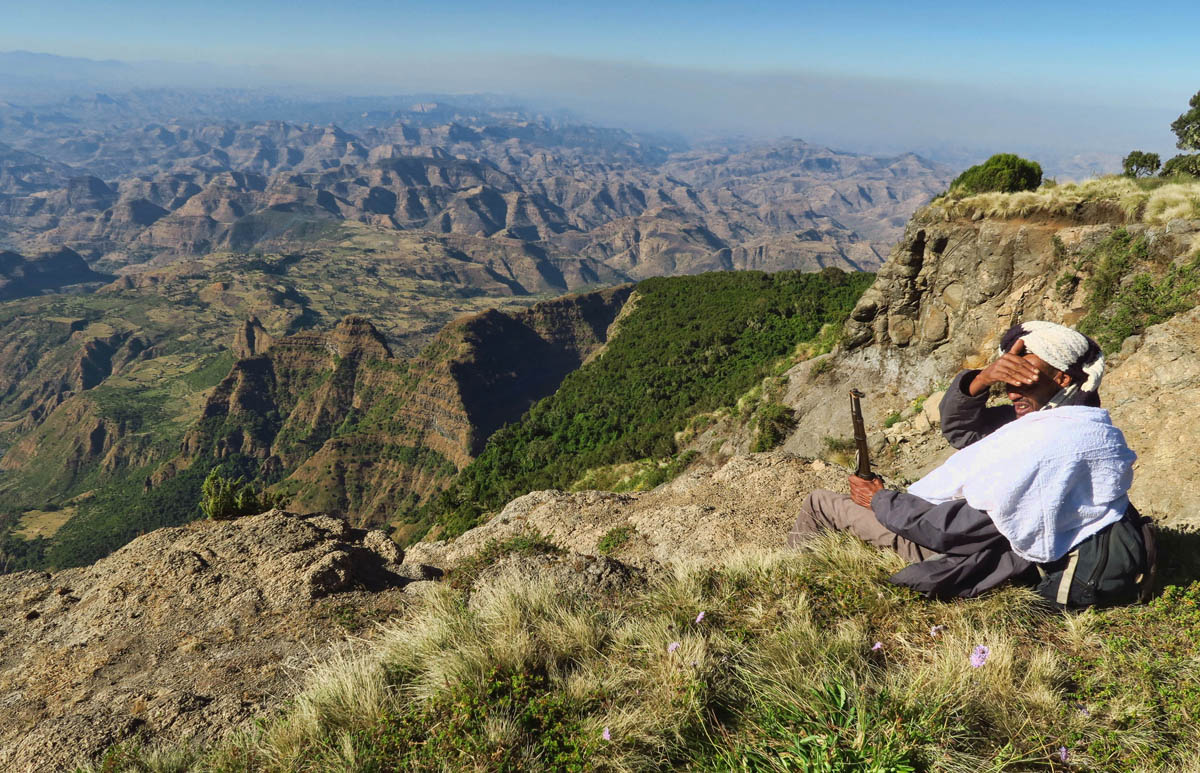
One of the scouts taking a rest with his rifle.

Lots of wildflowers in the lower vegetation zone.

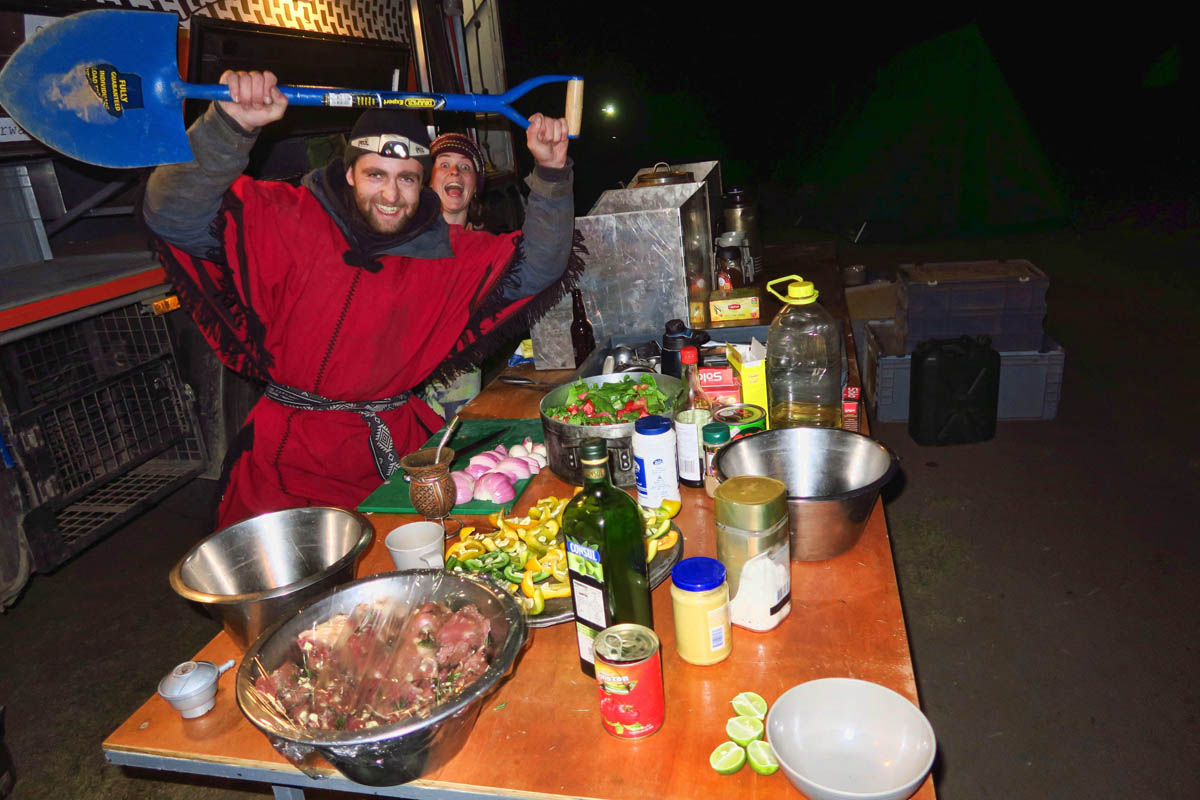
James and Louise are cooking us dinner on our first night at camp.
Our first night would be a camp spot near Sankaber at 3,250 meters, or 10,663 feet. I wasn’t fazed too badly by the altitude initially. However, we spent the second and third night at Chenek, a higher camp at 11,877 feet. Having just come from the family farm in Texas, elevation 660 ft above sea level, a week in Sudan on average of 1,200 ft wasn’t much of an acclimatization period for almost 12,000 ft. In fact, we were each given a chart to evaluate the signs of altitude sickness. Sitting around camp, I felt GREAT! However, as soon as I got up to move, it was like (for any Tarantino fans) Kill Bill’s “five point palm exploding heart technique.” Five steps away from the campfire, and I felt like I was going to collapse! While I eagerly anticipated doing the long hikes all three days, the reality of it was that I only managed to do the shorter hikes on the first and third day. I just couldn’t freekin BREATHE! (In retrospect, my 15 minutes on the Stairmaster back at the Main Street Gym was not enough prep for the Simiens.) 😉
Not only was the altitude breathtaking, but the scenery was equally so. As is often the case, photos can’t do it justice. We encountered three different vegetation zones, starting with the Afro-montane area with its thick juniper and acacia forests dripping with moss reminiscent of Savannah, Georgia, and ground cover of fragrant wild thyme. Moving higher, we reached the grassy plains, heavily harvested and grazed by livestock owned by the local farmers. And finally we reached the Afro alpine region where the Giant Lobella is prolific. Measuring up to 30 ft in height, the plant grows for as long as twenty years before flowering for the first time and then dying.
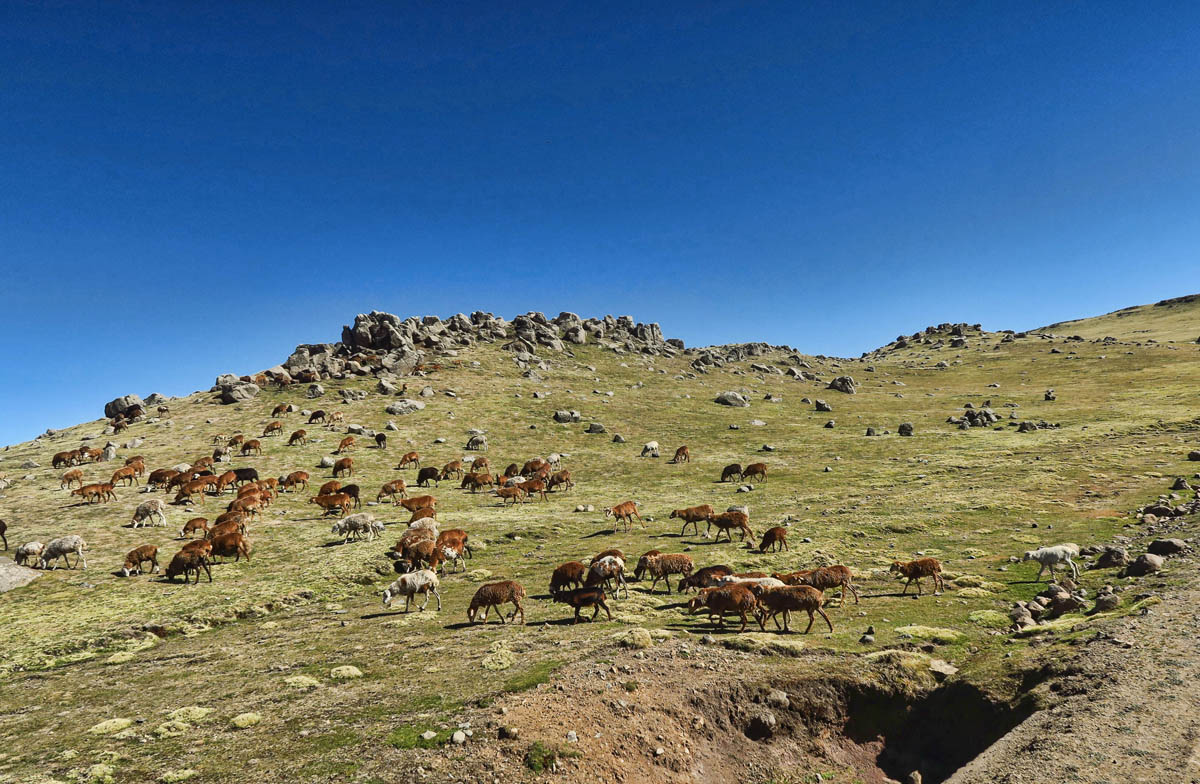
As we begin to climb up through the middle vegetation zone, the scenery turns to grasslands, and domestic livestock can be seen grazing.

Herders of the livestock are almost always children.

Terraces are man-made, grains are planted by oxen, and harvested by hand.
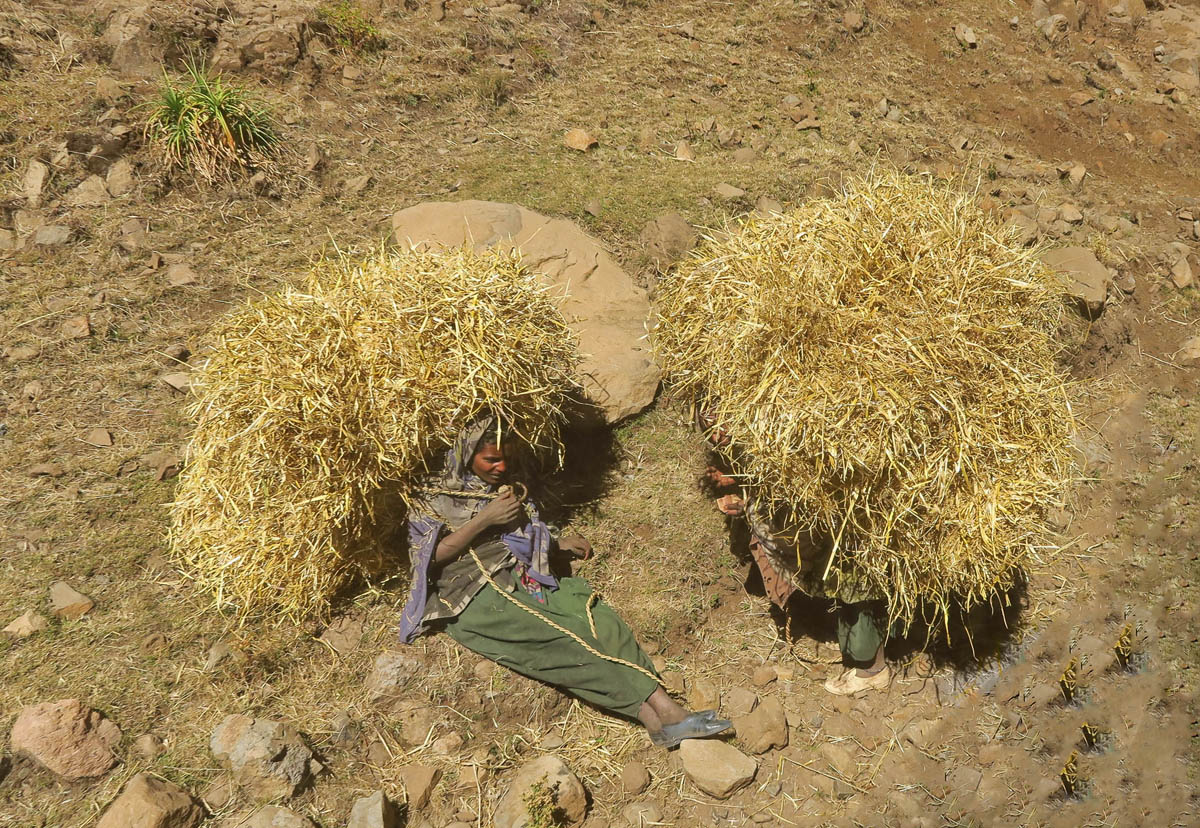
Hard to distinguish, as I took this photo through the window of the moving truck, but there are two women underneath these haystacks. They were toting them downhill and stopped for a rest.
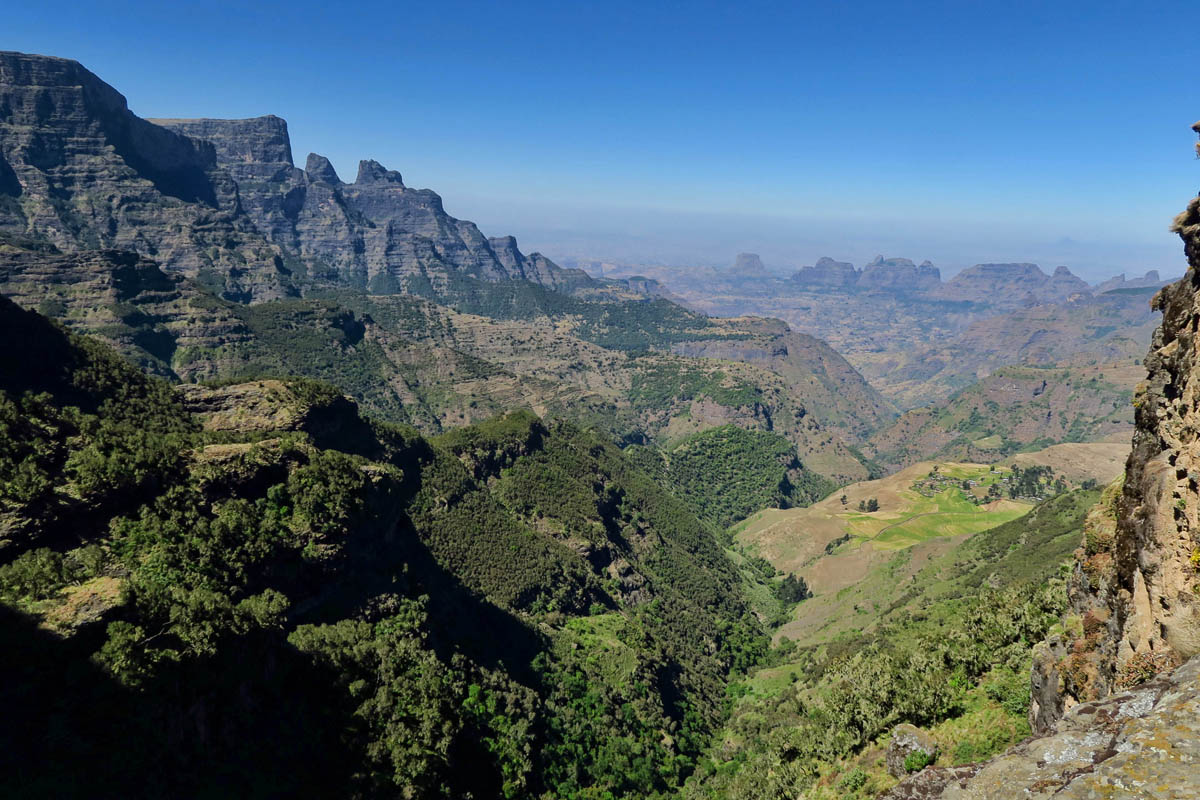
Finally, we are reaching what is known as the “afro alpine” vegetation zone.
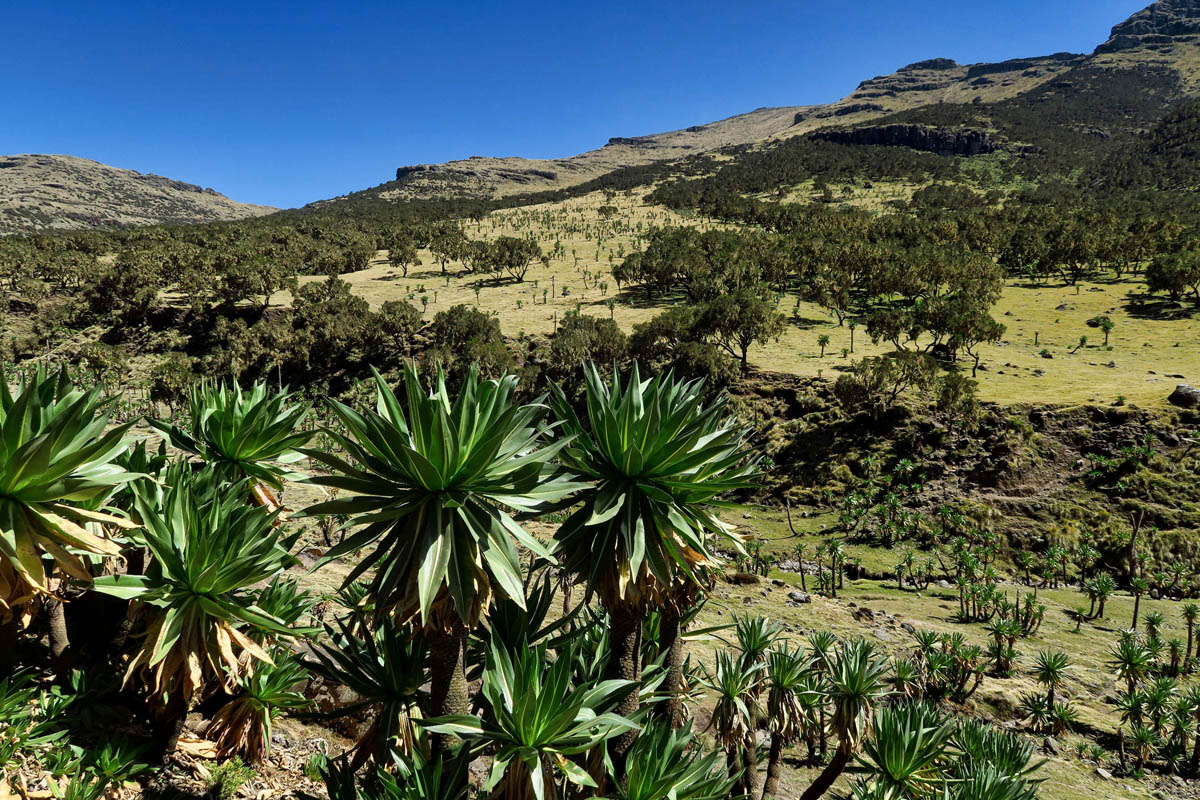
In this zone, trees have been replaced by the giant lobelia, or Lobelia rhynchopetalum, endemic to Ethiopia.

A view of camp life in the Chenek camp, elevation 3,620 meters, or 11,887 ft.
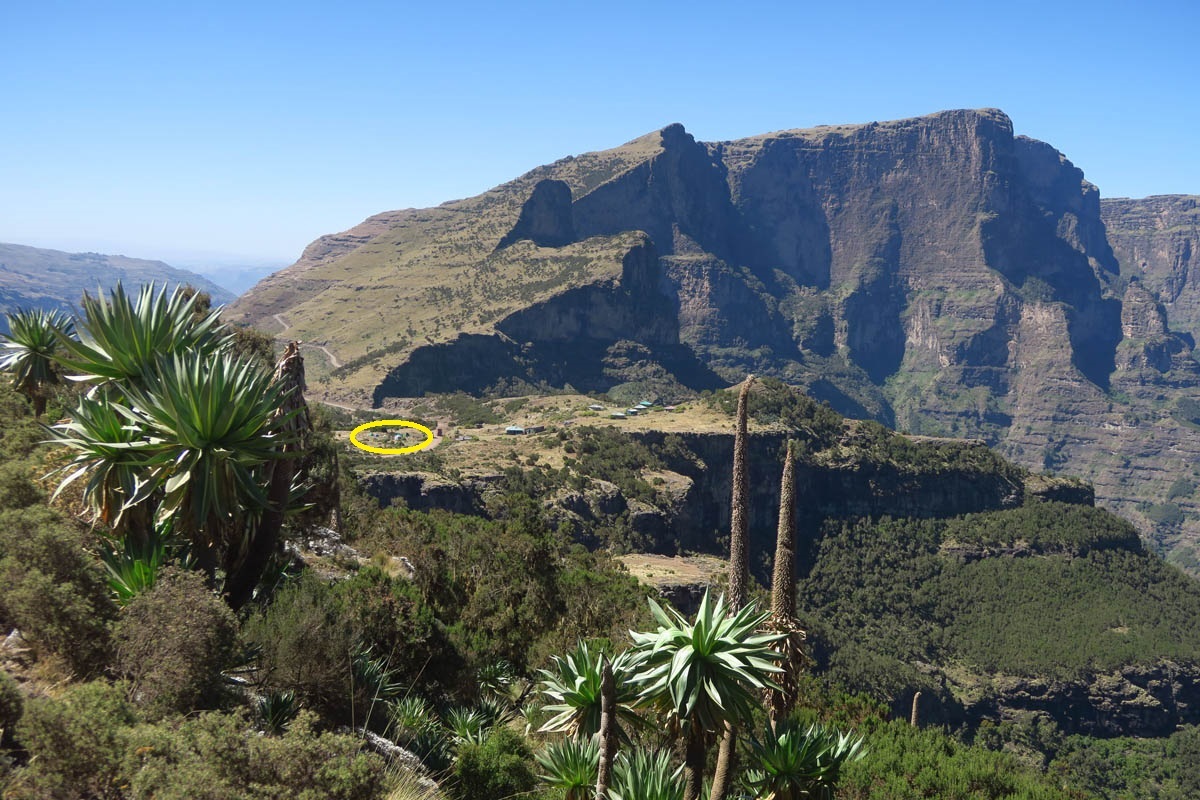
The yellow circle to the center-left shows the location of our camp in the distance as seen from our hike.
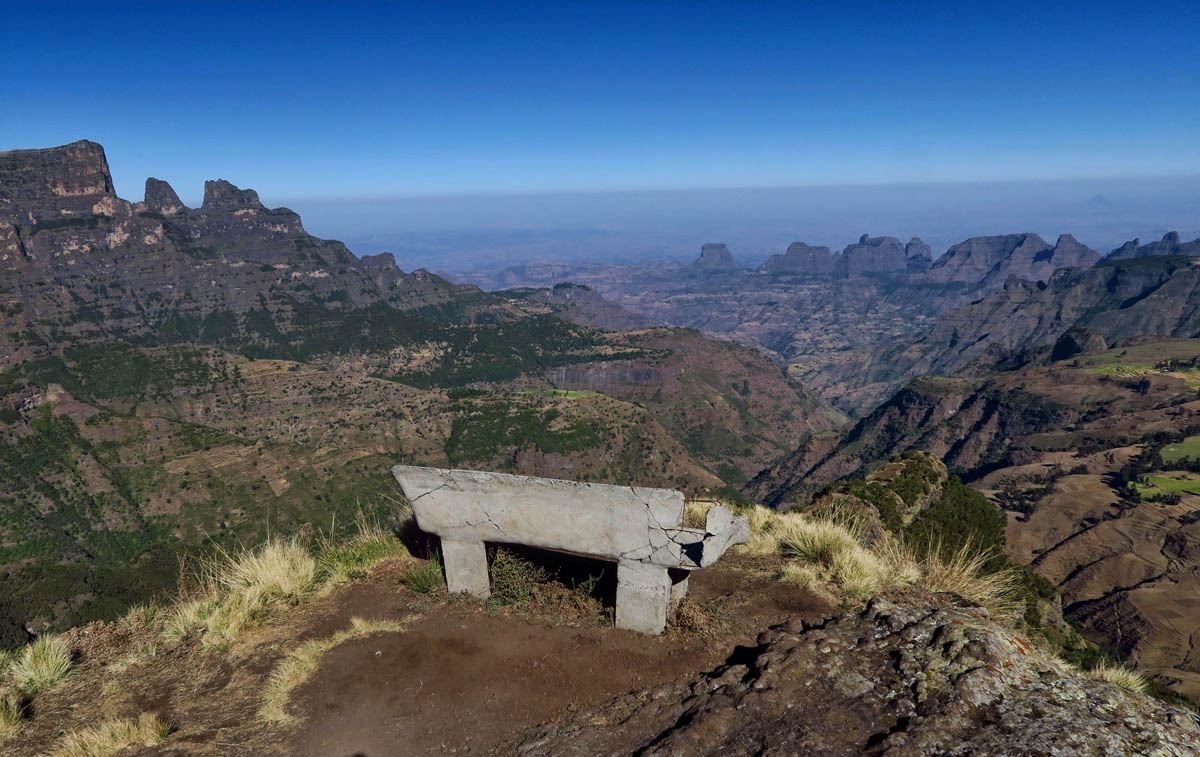
We start out on the hike along an overlook near camp where benches are there for taking in the view.

We are so lucky that our guides spotted not one, but two walia ibex. The photo is a bit blurry, because my point and shoot doesn’t have a great zoom, but you can make out one standing on the left, and another sitting on a higher rock ledge on the right.

This distant sighting is for my cousin Karen, if she is reading…a Lammergeier, or “bearded vulture” (Gypaetus barbatus) with a wingspan of 9-10 ft. Better known as a “brown bird.” 😉

It was day two before I spotted my first gelada baboons, and then it was only in the distance. All those tiny brown dots down along the ridge are a herd of geladas on the move.
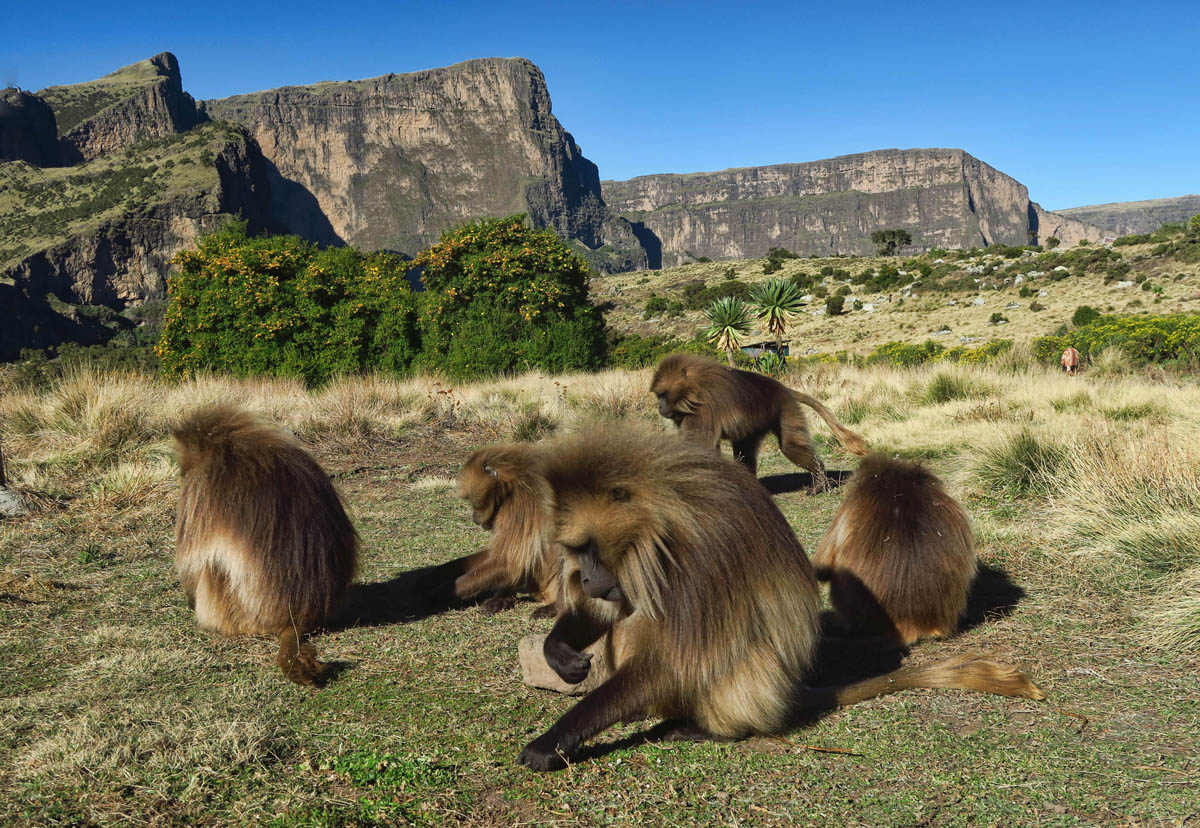
I was thrilled when we arrived at the campsite, and there they were grazing right where we would pitch our tents!

Geladas are the last surviving species of ancient grass-eating primates that were once numerous. They feed across the grasslands for up to 10 hours a day, then retreat to the cliff ledges where they sleep huddled together at night.

We saw them frequently on our third day of hiking. These two are grooming.
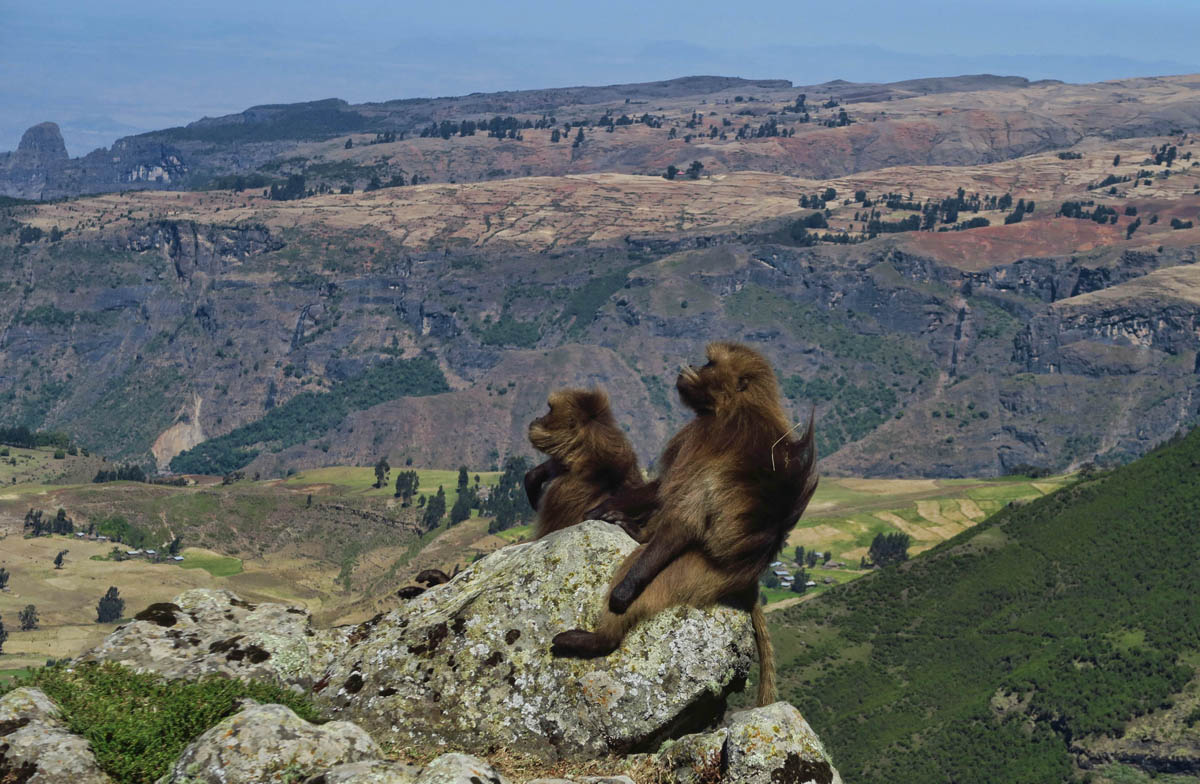
They have exceptionally long hair for primates. This guy is hanging out on the ledge, enjoying the updraft.

We had stopped for lunch when this pair came trotting along. Someone (not our group!) had dropped a baggie. This guy was not happy to find it empty!
While the walia ibex numbers are scarce (down to 500 worldwide,) not so for the gelada baboons (called “baboons,” but technically monkeys.) Their number is estimated to be somewhere around 3,000 in the park, 200,000 total, but found only in the Ethiopian Highlands. They are considered to be very intelligent. I found it so fascinating to learn from our guide that the geladas have learned to recognize skin color. Since they feed on grasses and roots, they are the enemy of the barley farmers, who often throw stones or sticks to scare them away. Therefore, the baboons have learned to associate black faces with danger, while they have come to learn that white faces wield only cameras. We were able to “co-mingle” with the baboons on our hikes as well as the campsite as they grazed through the grasslands.
Like so many of our national parks worldwide, the flora and fauna are all at risk. In the Simien Mountains National Park, there is a tug of war between the local people who have inhabited and cultivated the land for 2,000 years, and the conservationists who are working to protect the endangered species. In fact, there is a voluntary relocation program in place to entice the locals to move outside the park. It’s a tough call as the local farmers and their livestock compete for the main habitat of the walia ibex, gelada baboons, and Ethiopian wolves. And the local farmer population is growing just as fast as the animal species are declining, leading to soil degradation and overgrazing. The local people claim they were there first, before the area was designated as a national park. But it’s not always a matter of who was there first, but rather who will be there last. Me, I’m rooting for the geladas.
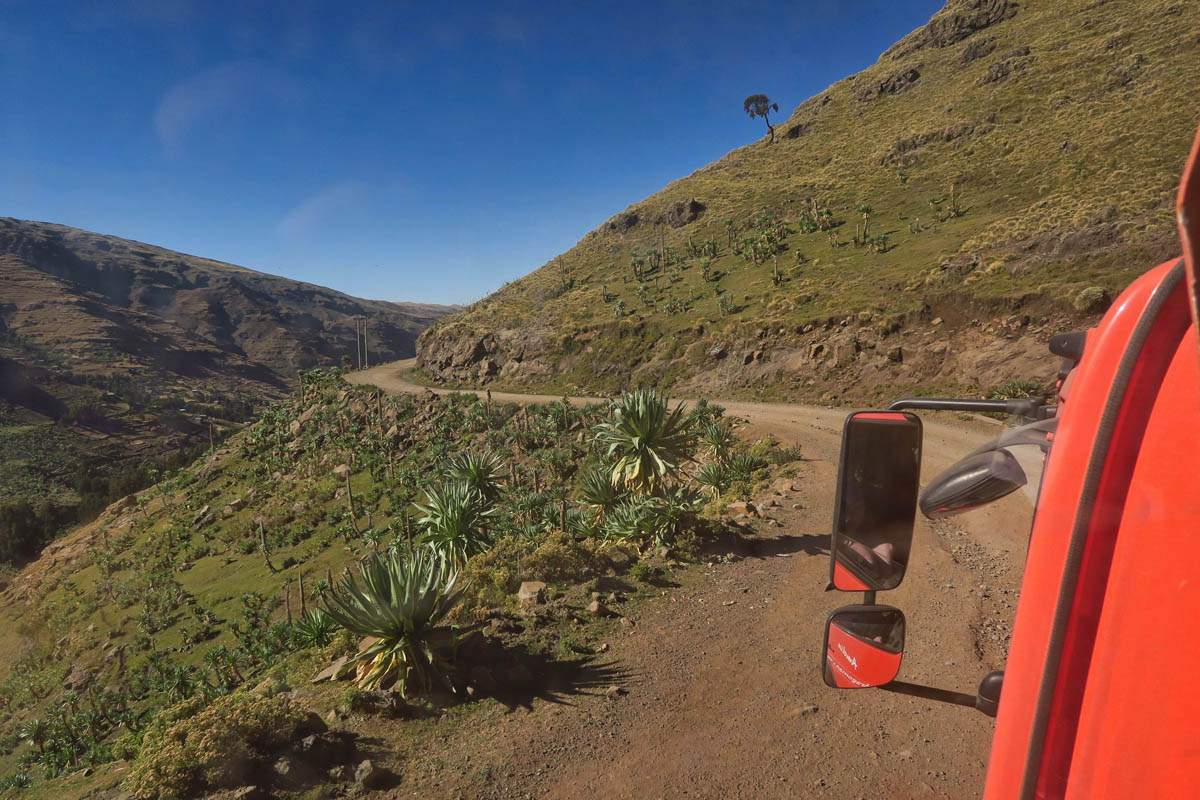
Leaving out on the last day…

Wonderful post! Next time, prior to a high altitude destination, go to a doc for Diamox Tablets! You have to take them a week before you go up . . .
Thanks, Terri. I didn’t have any symptoms of altitude sickness, thankfully. I only had shortness of breath while hiking, which I think is pretty normal due to the thin air. I was also feeling a bit depleted coming off two days of severe diarrhea.
I remember when I climbed Kilimanjaro back in 2002, they called Diamox the “pee pill” because it acted as a diuretic. I can understand taking it to stave off symptoms of sickness, i.e. headache, nausea, etc. But honestly, after having to unzip four zippers to get out of the tent to pee after drinking constantly all day trying to recoup my fluids from the diarrhea, I didn’t want to pee anymore than I had to!
I think I was probably better off on the shorter hikes anyway. I have difficulty keeping pace with most hikers as I am just not fast on or off the trail. Like John Muir, I am a saunterer. So the shortness of breath was just a good excuse to make the long-legged guides slow the heck down a bit. haha! What’s the damned hurry, I say!!??
OK, got it, but I worry about you cause altitude sickness sneaks up on folks like a “tired” feeling and if they don’t descend, it gets worse, much worse.
I’ve said it a million times but I think I enjoy your writing as much as, if not more than, your photos. For some reason the description of the baboon enjoying the updraft made me laugh out loud. I bet it did feel good! What were the temperatures like during the day?
Thanks, Kat! Hope you are enjoying the Tucson winter. We all stood laughing while watching that baboon bask in the breeze! He was really taking it in!
The daytime temps were absolutely perfect! Dry, cool air in the high 60’s. It was pleasant “sweater weather” right up until the sun dropped behind the mountains, but then the temps fell freakishly fast, which sent us all scrambling for fleece, hats, and gloves! I bought a new Mountain Gear down puffy right before I left, and I put it on at sundown each night, and didn’t take it off until after breakfast the next morning!
Lovely writing I agree! and baboons and Ibex! WOW!
Our experience with this kind of altitude was similar to yours but in the Snowy Range in Wyoming this past Autumn. I couldn’t breathe even lying down if I forgot to take very deep breaths I was out of air fast. Glad you are having such a great adventure!
I had low expectations for your trip in Ethiopia, but each posting is more delightful than the last. I was wondering about the damage to the vegetation by thousands of year of human activities so was delighted when you addressed the issue. I would hate to see the humans all made to leave the park, but hopefully some compromise will be made before all other life are eliminated. I have been following you on google map as my knowledge of the geology of the area you are in is completely alien to me and Deede. Wish we could be along, but I remember how we were effected by 9 or 19 thousand foot altitudes in Arizona and New Mexico and we would be lying around camp all day. The landscape and people are just fascinating. Thanks for this, google should hire you to take one of their 360 degree cameras along to record the roads.
How exciting to have the baboons right there up close and personal. Sorry to hear about your elevation troubles. It is amazing how hard it is to breath this high just walking let alone hiking. Glad you could do the small hikes. The NP sure does look like the Grand Canyon minus the red rock but such similar features.
I’ve been sharing your posts with my mother. She was so fascinated with the Sudan ones. My parents lived in Egypt for three years and my mother loves archaeology. She said she loved all the photos on the pyramids. She wishes she had been along.
Pam, what a nice comment! I have long said one of my reasons for writing the blog was so I could “bring Mom along.” I am delighted to have your Mom along for the ride as well!
Since my mother’s finances and knees won’t allow her to travel any longer, she appreciates joining you. My parents lived in many third world countries after my dad retired and worked with USAID. The remoteness of the country never bothered them.
But of course I’m reading along! Thanks, cuz for the “brown bird” pic! Doing a quick check of species in the Simien Mtns, most are brown or a variation thereof. Except the Blue-breasted Bee-eater – wow! I’m sure if you’d seen one of those, you would (finally) be converted into a birder.
And if you got too chilly at night, I feel confident one of those Geladas would have snuggled up with you!
What fun it is to travel along with you! Altitude can really be a bitch. Sometimes it bothers me and other times not…don’t know why! Your first picture of the Geladas I note there’s a person sitting off to the right so assume there’s also goats grazing along side the baboons, or is that just a guy sitting there?
Hi, Marti! It’s fun to have you and Ed traveling along with me! Thanks for the question. Good eye! I hadn’t noticed the man on the right. I zoomed in on the pre-compressed photo for a closer look. If you look dead center of the photo, just above the largest mass of tiny dots which are all geladas, you will see some larger livestock that appear to be sheep. Since the geladas are vegetarians, only after roots, they seem to co-mingle with the livestock. It’s the rock-throwing, stick wielding farmers they fear.
Hope you and Ed are having a mild winter, and looking forward to some good road trips soon!
Rifle-carrying scouts but “no real safety issue”?…Uh-huh. After that night just across the border I’d be totally okay with having them, for sure. What beautiful vistas Simien Mountains provided! I particularly admire the photo of the hanging moss and wild thyme…so very pretty! And a great pic of your intrepid guides cooking dinner for the group…their smiles must have been reassuring all along the way. In retrospect, beyond the difficulty of acclimating to the atmosphere, that National Park trek must have been amazing with those views and wild life. Those long hair baboons look pretty in the photos!
The most telling statement of this story, from one who is concerned with world overpopulation and climate change, is your musing about “who wil be there last”. I’d rather not think about that one as I believe we all know the answer, foretold long ago in celluloid version…”Planet of the Apes”. 🙁